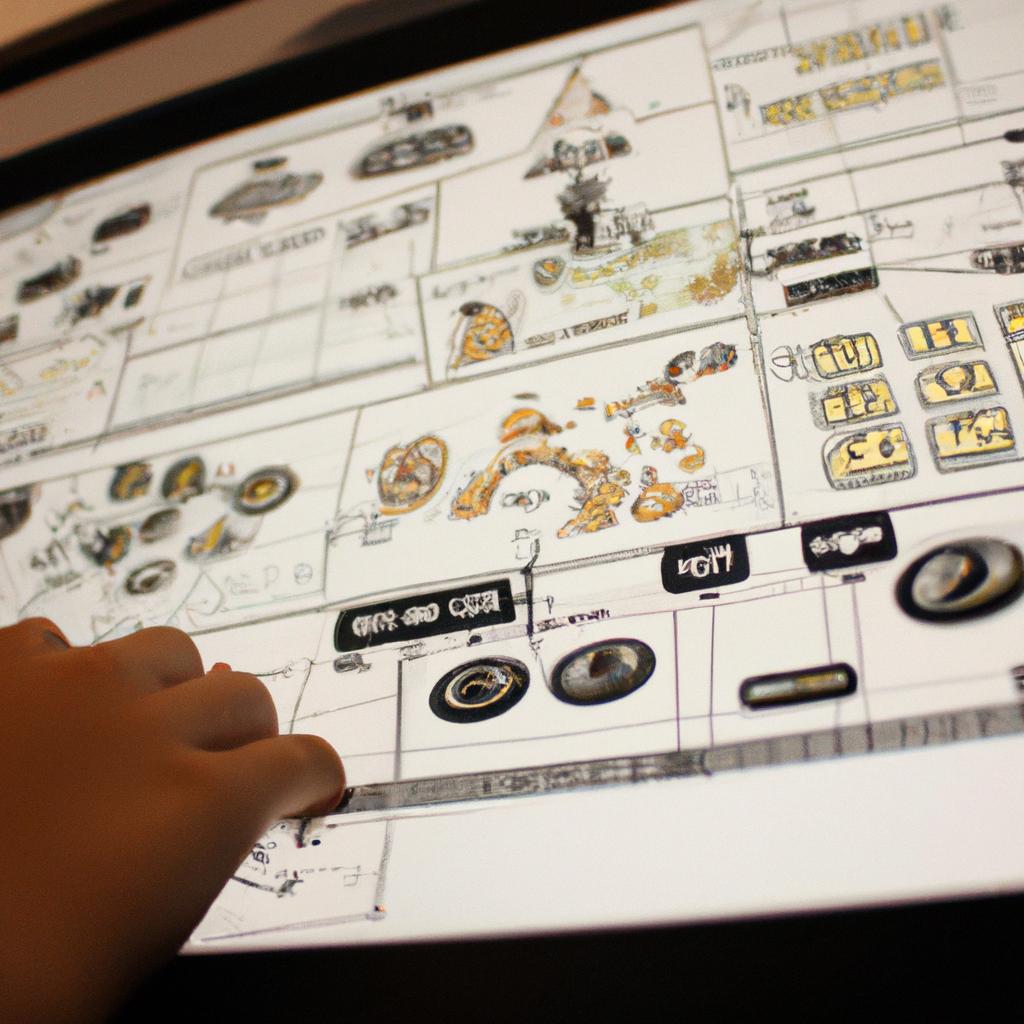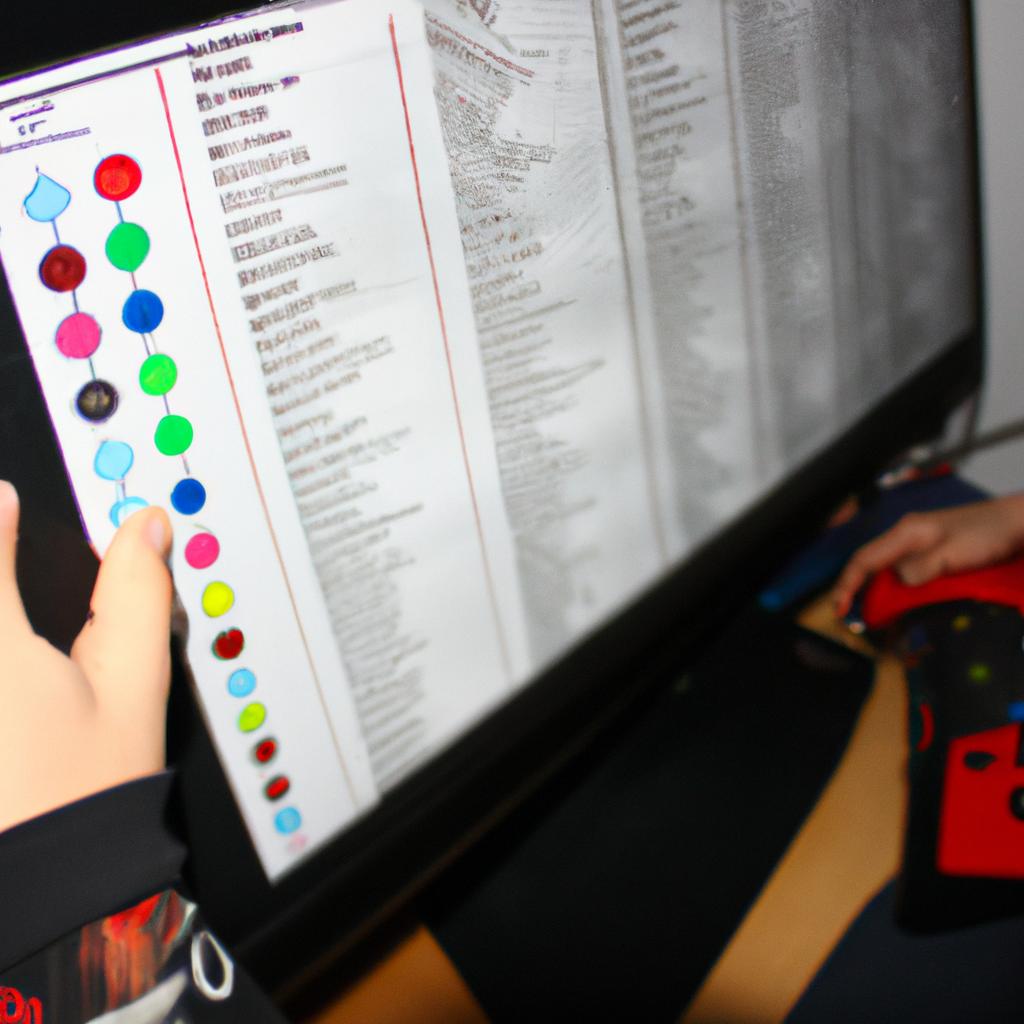Game Mechanics Unveiled: The Essence of Game Design in Games and Video Games

Game mechanics are the fundamental building blocks of game design, encompassing a wide range of interactive elements that shape gameplay experiences. Whether in traditional board games or modern video games, these mechanics dictate how players interact with and navigate through the virtual worlds they inhabit. For instance, consider the popular fantasy role-playing game “The Elder Scrolls V: Skyrim.” In this vast open-world adventure, players engage in combat, explore dungeons, and complete quests through a complex system of character progression, non-player character interactions, and environmental exploration. Understanding the essence of game mechanics is crucial for both designers seeking to create engaging experiences and players looking to unravel the intricacies behind their favorite games.
In recent years, there has been a growing interest among scholars and practitioners alike to dissect and analyze the underlying mechanisms that drive player engagement in various forms of gaming. This academic curiosity stems from the recognition that effective game design goes beyond mere entertainment value; it can also serve as a powerful tool for education, social interaction, and even psychological development. By studying game mechanics through an analytical lens, researchers hope to uncover patterns and principles that can inform future designs while shedding light on how individuals derive enjoyment from playing games. Moreover, understanding these core concepts allows developers to craft more immersive experiences by strategically incorporating elements such as progression systems, feedback loops, and player agency.
One important aspect of game mechanics is the concept of progression systems. These systems provide a sense of growth and accomplishment for players as they advance through the game. This can be achieved through leveling up characters, unlocking new abilities or items, or accessing higher levels of difficulty. Progression systems not only keep players engaged by offering tangible rewards but also create a sense of investment in the game world.
Feedback loops are another crucial component of game mechanics. These loops provide constant information to players about their actions and their impact on the game world. Positive feedback, such as receiving points or praise for completing tasks successfully, reinforces desired behaviors and motivates players to continue progressing. On the other hand, negative feedback, like losing health or failing a challenge, helps players learn from their mistakes and adjust their strategies accordingly.
Player agency refers to the degree of control and influence that players have over the game world. Mechanics that promote player agency allow individuals to make meaningful choices that affect gameplay outcomes. This can include decision-making processes related to character customization, branching storylines with multiple endings, or strategic planning during gameplay. By empowering players with agency, games become more immersive and personalized experiences.
Incorporating these elements into game design requires careful consideration of how they interact with each other and contribute to overall player engagement. Game designers must strike a balance between providing enough challenge to keep players motivated while ensuring that gameplay remains accessible and enjoyable. Additionally, understanding player preferences and motivations is essential for tailoring mechanics to specific target audiences.
Overall, game mechanics form the foundation upon which memorable gaming experiences are built. By understanding and utilizing these core concepts effectively, developers can create engaging worlds that captivate players while offering opportunities for growth, exploration, and enjoyment
Understanding Game Mechanics
Imagine you are playing a video game where your objective is to rescue a princess from a castle guarded by vicious dragons. As you navigate through the treacherous paths and battle enemies, your character gains experience points and levels up, acquiring new abilities and weapons along the way. These elements are all part of the intricate web known as game mechanics – the rules, systems, and interactions that govern gameplay.
Game mechanics serve as the backbone of any game or video game, influencing player engagement, progression, and enjoyment. They provide structure and define how players interact with the virtual world, shaping their experiences throughout the gameplay journey. To fully comprehend game mechanics, it is essential to explore their various aspects in depth.
One fundamental aspect of understanding game mechanics involves recognizing their impact on player emotions. Engaging games often evoke a range of emotions within players: excitement when conquering challenges; frustration when facing difficult obstacles; satisfaction upon achieving goals; and even fear or anticipation during intense moments. The interplay between different mechanics can intensify these emotional responses. For instance:
- Achievement System: Unlocking achievements after completing specific tasks provides a sense of accomplishment.
- Time Pressure: Imposing time limits adds tension and urgency to decision-making processes.
- Risk-Reward: Balancing risks against potential rewards creates suspense and motivates strategic thinking.
- Progression Pathways: Offering multiple pathways for advancement grants players autonomy and fosters a feeling of personal growth.
To illustrate further, consider Table 1 below showcasing different game mechanics commonly found in adventure-based role-playing games (RPGs):
| Mechanic | Description |
|---|---|
| Character Creation | Allows players to customize their avatars based on preferred traits and attributes. |
| Quest System | Offers players objectives or missions to complete, driving narrative progression. |
| Combat Mechanics | Involves engaging in battles using various techniques and strategies to defeat enemies. |
| Inventory Management | Requires managing resources, items, and equipment to optimize gameplay effectiveness. |
Understanding these game mechanics is crucial not only for game designers but also for players seeking more enriching gaming experiences. By recognizing how each mechanic contributes to the overall gameplay, individuals can make informed decisions when selecting games that align with their preferences.
Transitioning into the subsequent section about “The Role of Game Mechanics in Gameplay,” it becomes evident that delving deeper into this topic will shed light on how these mechanics shape player engagement and contribute to the essence of game design.
The Role of Game Mechanics in Gameplay
Section H2: The Role of Game Mechanics in Gameplay
Transitioning from our previous exploration of game mechanics, let us now delve into the crucial role they play in shaping gameplay experiences. To illustrate this concept, consider a hypothetical scenario where players find themselves immersed in an action-packed video game set in a post-apocalyptic world. In this game, one of the core mechanics is resource management, requiring players to scavenge for supplies and make strategic decisions on how to allocate limited resources such as food, ammunition, and medical supplies.
Firstly, game mechanics serve as the backbone that structures player actions and interactions within a game. They establish rules and guidelines that define what can be done, how it can be done, and the consequences of those actions. By providing clear objectives and constraints, game mechanics create meaningful choices for players to navigate through various challenges and obstacles presented by the game world.
Secondly, game mechanics contribute significantly to player engagement and motivation. As we explore different types of games across genres or platforms, we encounter numerous examples where carefully crafted mechanics enhance user enjoyment. For instance:
- Achievements that unlock special rewards after completing specific tasks.
- Leveling up systems that provide a sense of progression and accomplishment.
- Dynamic difficulty adjustments that tailor the challenge level based on player performance.
- Social interaction features enabling multiplayer collaboration or competition.
These elements effectively tap into human psychology by appealing to our desire for achievement, recognition, growth, and social connection – driving us to invest more time and effort into playing these games.
To further understand the impact of game mechanics on gameplay experiences holistically, let’s examine their influences through a table:
| Influence | Description | Example |
|---|---|---|
| Player agency | Empowers players with control over their own actions | Giving players multiple paths to choose from |
| Immersion enhancement | Deepens player involvement in the virtual game world | Realistic physics simulation |
| Emotional response elicitation | Evokes a wide range of emotions in players | Implementing surprise elements |
| Skill development | Fosters the growth and improvement of player abilities | Gradually introducing new challenges |
In conclusion, game mechanics are fundamental components that shape gameplay experiences. By providing structure, defining rules, and enhancing engagement, they enable players to immerse themselves in virtual worlds and elicit emotional responses.
Common Types of Game Mechanics
In the previous section, we explored the crucial role game mechanics play in shaping gameplay experiences. Now, let us delve deeper into some common types of game mechanics and their effects on players.
Case Study Example: Consider a popular open-world adventure game where players control a skilled assassin navigating through complex missions. One prominent game mechanic in this title is stealth, which allows players to remain undetected by enemies while completing objectives. This mechanic adds an element of strategy as players must carefully plan their movements and actions to avoid detection, enhancing both the challenge and immersion of the gameplay experience.
Types of Game Mechanics
Game designers employ various game mechanics to create engaging experiences for players. Here are four commonly used mechanics:
- Progression: Many games incorporate progression systems that reward player advancement with new abilities or content. These can include leveling up characters, unlocking new weapons or skills, or accessing previously inaccessible areas. Progression mechanics provide a sense of achievement and motivate players to continue playing.
- Puzzle Solving: Games often feature puzzles that require critical thinking and problem-solving skills from players. Such challenges promote cognitive engagement and satisfaction upon successfully overcoming obstacles.
- Resource Management: In certain genres like survival or strategy games, resource management becomes a vital game mechanic. Players must allocate limited resources effectively to sustain themselves or build their bases, adding depth and realism to the gameplay experience.
- Player Choice & Consequence: Giving players meaningful choices that impact the narrative or outcome is another powerful mechanic found in many modern games. These choices imbue a sense of agency in players, making them feel more connected to the virtual world they inhabit.
Understanding the Impact
To better understand how different game mechanics affect player experiences, let’s examine their potential emotional responses using a table:
| Game Mechanic | Emotional Response |
|---|---|
| Stealth | Suspense |
| Progression | Achievement |
| Puzzle Solving | Satisfaction |
| Resource Management | Tension |
This table illustrates how game mechanics can evoke various emotional responses in players, enhancing their engagement and enjoyment throughout the gaming experience.
As we move forward, it is important to recognize that achieving a seamless gameplay experience requires striking a careful balance between different game mechanics. In the subsequent section on “Balancing Game Mechanics for a Seamless Experience,” we will explore strategies employed by designers to harmonize these mechanics effectively without overwhelming or underwhelming players.
Balancing Game Mechanics for a Seamless Experience
Imagine a role-playing video game where players embark on an epic quest to defeat a powerful dragon and save their kingdom. As they navigate through treacherous landscapes, engage in thrilling combat encounters, and unravel intricate storylines, what keeps them hooked? The answer lies in the carefully crafted game mechanics that underpin the entire gameplay experience. In this section, we will delve into the influence of game mechanics on player behavior, shedding light on how these elements shape and guide players’ actions within games.
The Role of Game Mechanics:
Game mechanics serve as the building blocks upon which games are constructed. They encompass rules, systems, and interactions designed to provide structure and challenge for players. By defining boundaries, goals, rewards, and consequences, game mechanics establish a framework that guides players’ decision-making processes throughout their gaming journey. For instance, let’s consider an open-world adventure game with various side quests scattered across its vast landscape. Through well-designed quest markers and objective tracking mechanisms, the game mechanic empowers players to prioritize certain tasks over others while maintaining a sense of autonomy.
Influence on Player Behavior:
Effective game mechanics have a profound impact on player behavior by evoking emotions such as excitement, satisfaction, frustration or even fear. To understand this further, let us examine four key ways in which game mechanics can shape player experiences:
- Progression Systems: Leveling up abilities or unlocking new content provides players with a sense of accomplishment and progression.
- Competition Dynamics: Engaging in multiplayer modes or leaderboard challenges fosters healthy competition among players.
- Decision-Making Impact: Choices presented to players during critical moments create tension and imbue a feeling of agency.
- Feedback Loops: Timely feedback through visual cues or audio effects enhances immersion and reinforces desired behaviors.
To illustrate the significance of game mechanics in influencing player behavior more tangibly, consider the following table showcasing the impact of different mechanics on player emotions:
| Game Mechanic | Emotion Evoked |
|---|---|
| Time Pressure | Excitement |
| Risk-Reward | Tension |
| Exploration | Curiosity |
| Customization | Personal Pride |
The Impact of Game Mechanics on Player Engagement:
Understanding how game mechanics shape player behavior is crucial for game designers seeking to create engaging experiences. By carefully crafting and balancing these elements, developers can tap into players’ intrinsic motivations, fostering a sense of enjoyment and immersion. In the subsequent section, we will explore the specific ways in which game mechanics contribute to enhancing player engagement.
Transitioning seamlessly from our discussion on game mechanics’ influence on player behavior, let us now delve deeper into examining their impact on player engagement.
The Impact of Game Mechanics on Player Engagement
Having explored the importance of balancing game mechanics for a seamless experience, we now delve into the profound impact these mechanics have on player engagement. To illustrate this, let us consider the popular open-world role-playing game “Fantasy Realm.” In this immersive virtual world, players navigate through vast landscapes, interact with diverse characters, and undertake thrilling quests to progress their character’s storyline.
Game mechanics play a pivotal role in capturing and maintaining player engagement throughout their gaming journey. By offering meaningful choices and challenges, they keep players invested in the game world and motivate them to continue playing. Here are some key ways in which game mechanics influence player engagement:
-
Progression Systems: Implementing well-designed progression systems is crucial for fostering player engagement. As players accomplish tasks or overcome obstacles within the game, they should be rewarded with tangible benefits such as unlocking new abilities or acquiring rare items. This sense of achievement motivates players to persistently strive for further advancement, heightening their overall engagement.
-
Narrative Interactivity: Engaging storytelling combined with interactive gameplay enhances player immersion and emotional investment. When players can shape the narrative outcome through their actions and decisions, they feel a heightened sense of agency within the game world. This interplay between story-driven elements and interactive mechanics fuels player curiosity and compels them to explore various possibilities.
-
Social Interaction: Incorporating opportunities for social interaction fosters a strong sense of community among players. Multiplayer features like cooperative missions or competitive modes create avenues for collaboration or friendly competition, sparking social connections both within and beyond the gaming realm. These interactions contribute significantly to long-term player engagement by providing additional layers of enjoyment derived from shared experiences.
-
Feedback Systems: Providing timely feedback is essential for sustaining player motivation and guiding their progress effectively. Well-crafted visual cues, audio prompts, and intuitive user interfaces inform players about their accomplishments, challenges, and overall game state. Clear feedback empowers players to make informed decisions, adapt their strategies, and stay engaged in the gameplay experience.
Table: Emotional Response Elicited by Game Mechanics
| Game Mechanic | Emotional Response |
|---|---|
| Reward Systems | Excitement |
| Choice-making | Empowerment |
| Collaboration | Connection |
| Progression | Achievement |
In conclusion, game mechanics exert a profound impact on player engagement by offering incentives for progression, enabling narrative interactivity, fostering social interaction, and providing informative feedback. These elements combine to create an immersive gaming experience that captivates players’ attention and keeps them invested in the virtual world of the game. Building upon this foundation allows designers to explore evolving trends and innovations in game mechanics.
Transition into subsequent section:
As we witness the ever-evolving landscape of games and video games, understanding how game mechanics continue to shape player experiences becomes increasingly crucial.
Evolving Game Mechanics: Trends and Innovations
Section H2: Evolving Game Mechanics: Trends and Innovations
Building upon the impact of game mechanics on player engagement, it is evident that the ever-changing landscape of games and video games necessitates continuous evolution in their core mechanics. As designers strive to captivate audiences with new experiences, they explore emerging trends and innovative approaches that redefine how players interact with virtual worlds.
Evolving Game Mechanics Through Immersive Storytelling:
One example showcasing the evolving nature of game mechanics lies within the realm of immersive storytelling. Games like “The Witcher 3: Wild Hunt” have demonstrated how a captivating narrative can be intricately woven into gameplay mechanics, enhancing both player engagement and emotional investment. By seamlessly integrating choices and consequences into the fabric of the story, this critically acclaimed title allowed players to shape their own unique paths through morally complex quests.
Emotional Impact Amplified:
To evoke an even stronger emotional response from players, contemporary game design has witnessed innovations in incorporating psychological elements into core mechanics. Consider these key developments:
- Dynamic soundscapes that adapt to player actions heighten suspense and create a more immersive experience.
- Non-player characters (NPCs) exhibiting realistic emotions through advanced artificial intelligence algorithms foster deeper connections between players and virtual personalities.
- Implementing moral dilemmas where decisions carry far-reaching consequences challenges players’ ethical frameworks and elicits thought-provoking reactions.
- Inclusion of haptic feedback technologies enhances sensory immersion by allowing players to physically feel in-game events.
Table: Psychological Elements Integrated Into Core Mechanics
| Key Development | Emotional Effect |
|---|---|
| Adaptive Soundscapes | Heightened suspense |
| Realistic NPC Emotions | Deeper connection with virtual personalities |
| Moral Dilemmas | Thought-provoking decisions |
| Haptic Feedback Technologies | Enhanced sensory immersion |
Looking Ahead: Future Possibilities
As game designers continue to push the boundaries of interactive experiences, several trends are emerging that hold promise for evolving game mechanics:
- Augmented Reality (AR) and Virtual Reality (VR) technologies offer unprecedented opportunities for immersive gameplay, blurring the lines between virtual and real-world interactions.
- Procedural generation techniques enable games to create vast and diverse worlds dynamically, providing endless possibilities for exploration.
- Integration of machine learning algorithms can tailor gameplay experiences based on individual player preferences, ensuring a personalized journey through each game.
- The rise of cloud gaming platforms allows for seamless multiplayer experiences across various devices, fostering social connections within expansive virtual landscapes.
By embracing these advancements in technology and design philosophy, future iterations of games and video games have the potential to captivate players like never before.
This section illustrates how game mechanics constantly evolve to meet the demands of an ever-evolving industry. Through integrating storytelling elements into core mechanics and incorporating psychological aspects, developers strive to create captivating experiences that resonate with players emotionally. As we look toward the future, emerging trends such as augmented reality, procedural generation, machine learning, and cloud gaming present new opportunities for further innovation in the realm of game mechanics. With each iteration pushing boundaries and redefining what is possible in interactive entertainment, players can anticipate even more engaging and immersive virtual experiences ahead.








